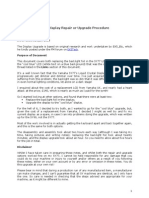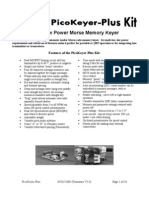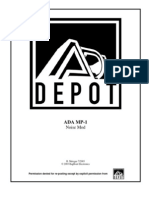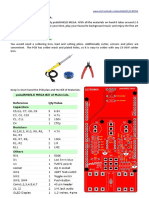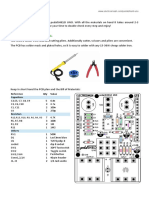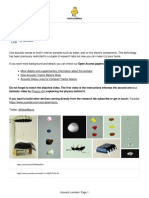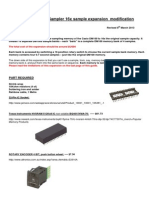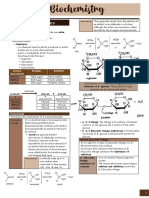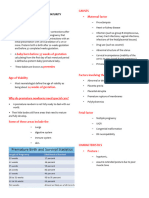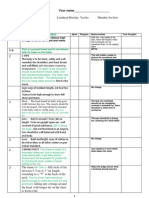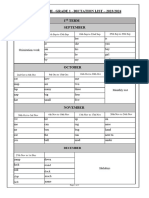TuringMachine Expanders 1.1
TuringMachine Expanders 1.1
Uploaded by
Nico PinealCopyright:
Available Formats
TuringMachine Expanders 1.1
TuringMachine Expanders 1.1
Uploaded by
Nico PinealOriginal Description:
Copyright
Available Formats
Share this document
Did you find this document useful?
Is this content inappropriate?
Copyright:
Available Formats
TuringMachine Expanders 1.1
TuringMachine Expanders 1.1
Uploaded by
Nico PinealCopyright:
Available Formats
Turing Machine Random Looping
Sequencer Expanders.
Eurorack DIY Kit
Instructions
Version 1.1
OVERVIEW
For the most recent version of this
document please visit
www.thonk.co.uk
For all technical support please visit
http://bit.ly/17CetJb on Muffwiggler.
This document is an alternative to the
build documentation available on the
Music Thing Modular website.
http://musicthing.co.uk/modular/?page
_id=323
All Thonk kits are sold under our standard Terms and Conditions.
DIY INSTRUCTIONS
This document gives detailed instructions that assume you have purchased a
complete kit from www.thonk.co.uk. It also assumes no previous knowledge of
electronics. To learn to solder try http://youtu.be/I_NU2ruzyc4
Watch and understand that whole YouTube video! If youre not achieving the
results shown in the video then you need to buy new tools or seek advice.
You will not end up with a working module otherwise.
TOOLS REQUIRED
Soldering iron, pliers, wire strippers, small flat head screwdriver and diagonal
cutters AKA snips AKA side-cutters. A Digital Multimeter is always helpful for
checking for bad solder joints and continuity. Thonk sell a range of
inexpensive tools here.
October 25th 2013
www.thonk.co.uk
Turing Machine Random Looping
Sequencer Expanders.
Eurorack DIY Kit
Instructions
Version 1.1
BACKPACK BUILD INSTRUCTIONS
1.
Start by emptying the BACKPACK
bag into a bowl or container. This
makes it much easier to pick parts as
you need them and youre less likely
to lose anything.
2.
Start by taking the two black and
silver diodes from the protective ESD
bag and solder into place. Note that
the silver end of both diodes faces
the Music Thing Modular logo on the
PCB.
NOTE: Correct orientation is vital.
NOTE: Diodes can be damaged by
excessive heat from the soldering
iron, solder quick, do not let the tip
rest on the lead for more than 5
seconds.
October 25th 2013
www.thonk.co.uk
Turing Machine Random Looping
Sequencer Expanders.
Eurorack DIY Kit
Instructions
Version 1.1
3.
Next solder the 4 IC Sockets into
place.
4.
Take the two 78L09 regulators out of
the protective ESD packaging and
solder into place. The middle leg
needs to be bent outwards slightly to
fit. The flat face on the components
should align with the flat edge on the
silkscreen on the PCB.
NOTE: Correct orientation is vital.
5.
Solder the two orange polyfuses into
place next to the diodes. The
orientation on these is not important
either way is fine.
October 25th 2013
www.thonk.co.uk
Turing Machine Random Looping
Sequencer Expanders.
Eurorack DIY Kit
Instructions
Version 1.1
6.
Solder the 3 headers into place,
the single 10 pin and two 16 pin.
7.
Now flip the board over and solder
the two black plastic female headers
into place, a two row ten pin header
and a single row ten pin header.
October 25th 2013
www.thonk.co.uk
Turing Machine Random Looping
Sequencer Expanders.
Eurorack DIY Kit
Instructions
Version 1.1
8.
Now insert the four ICs as shown,
make sure the notch in the top of the
IC matches the notch in the socket.
NOTE: Correct orientation is vital.
9.
Now take your Turing machine module, remove the power cable and fit the
backpack into place like so.
Plug the original power cable into the backpack with the red stripe as shown.
This is a good point to just quickly test your Turing Machine with backpack
attached. It should operate completely normally.
The only difference right now is that you Turing Machine is now also protected
from having the power cable connected backwards! You dont want to be
aggressively testing that feature though!
Youre now ready to move onto building the expander modules, PULSES
and/or VOLTAGES.
October 25th 2013
www.thonk.co.uk
Turing Machine Random Looping
Sequencer Expanders.
Eurorack DIY Kit
Instructions
Version 1.1
PULSES BUILD INSTRUCTIONS
10.
Start by emptying the PULSES bag
into a bowl or container. This makes
it much easier to pick parts as you
need them and youre less likely to
lose anything.
Its advised to paint the front panel
AFTER the electronic construction is
complete.
11.
Start with the seven 2.1K Resistors
in positions LR1-LR7.
These are the resistors on the
outside edge of the board. These
resistors are mounted vertically as
shown below.
12.
Next solder the remaining seven 1K Resistors in
positions R1-R7.
These are the resistors on the inside edge of the
board. These resistors are also mounted vertically as
shown below. They should be soldered in a mirrored
formation. If fitted neatly there should be no chance
of shorting with the paired resistor.
October 25th 2013
www.thonk.co.uk
Turing Machine Random Looping
Sequencer Expanders.
Eurorack DIY Kit
Instructions
Version 1.1
13.
Next solder the 7 red LEDs into
place. The long lead/leg on the LED
is the positive terminal, the Anode.
This should go into the hole marked
with a +.
14.
Now flip the PCB over and solder the
IC socket and Expansion header into
place.
TAKE CARE: Ensure the notch in
one end of the IC Socket is aligned
with the silkscreen outline on the
PCB.
15.
Now put the seven jack sockets into
place on the PCB but DO NOT
SOLDER YET.
October 25th 2013
www.thonk.co.uk
Turing Machine Random Looping
Sequencer Expanders.
Eurorack DIY Kit
Instructions
Version 1.1
16.
With the jacks still NOT soldered, temporarily put the front panel on and hand
tighten the nuts.
Make sure the PCB is parallel to the frontpanel and all the jacks are properly
seated, then solder all 4 terminals on all 7 jacks. Its best to solder like this
with the panel loosely in place as it eliminates the possibility of your jacks not
matching up properly with the holes in the panel.
You can now remove the panel for painting later.
17.
Insert the IC as shown, with the
indentation in one end of the IC
matching the notch in the IC Socket.
NOTE: CORRECT ORIENTATION
OF IC IS VITAL TO AVOID
DAMAGE.
October 25th 2013
www.thonk.co.uk
Turing Machine Random Looping
Sequencer Expanders.
Eurorack DIY Kit
Instructions
Version 1.1
18.
Next you should test your PULSES
module by hooking up to the
BACKPACK which is fitted to your
Turing Machine.
Use the 16 pin ribbon cable and
attach to the top PULSES header on
the
BACKPACK.
Ensure
you
correctly orient the red stripe of the
ribbon cable on both modules.
Your PULSES expander is now ready
for use.
October 25th 2013
www.thonk.co.uk
Turing Machine Random Looping
Sequencer Expanders.
Voltages expander
Eurorack DIY Kit
Instructions
Version 1.1
(see photos after text)
1. This is a very quick, straightforward build, so long as you do everything in
the right order!
2. Start on the back of the board, the side with the large Music Thing Modular
logo. Mount the IC socket, power header and R1.
3. Two important notes about resistor networks:
a. Unlike normal resistors, they have a polarity. They have a mark at one end,
usually a spot. Ensure the mark lines up with the cross on the silkscreen.
b. The two networks in this module look the same but are NOT
interchangeable.
103LF = 10k = back of board, close to the power header
202LF = 2k = front of board, next to Inspiration
4. One the back of the board is populated, carefully trim the leads as neatly as
you can. If they stick up too far, theyll make it hard to get the faders in straight.
5. Attach the other components on the front of the board, around the faders;
resistors, capacitors, the 78l09 voltage reference, sockets, and the 2k resistor
network.
6. Be careful with the potentiometers. again, they look similar, but are different.
Scale, on the left as you look at the faders, is 10k. Offset, on the right, is 50k.
7. Finally, install the faders. They will slot neatly into place. Push them in
firmly, ensure all the pins are through the holes and that the plastic feet of
the fader are flush against the PCB, then solder.
October 25th 2013
www.thonk.co.uk
10
Turing Machine Random Looping
Sequencer Expanders.
October 25th 2013
Eurorack DIY Kit
Instructions
www.thonk.co.uk
Version 1.1
11
Turing Machine Random Looping
Sequencer Expanders.
Eurorack DIY Kit
Instructions
Version 1.1
October 25th 2013
www.thonk.co.uk
12
Turing Machine Random Looping
Sequencer Expanders.
October 25th 2013
Eurorack DIY Kit
Instructions
www.thonk.co.uk
Version 1.1
13
Turing Machine Random Looping
Sequencer Expanders.
October 25th 2013
Eurorack DIY Kit
Instructions
www.thonk.co.uk
Version 1.1
14
You might also like
- How To Replace C52 KefDocument7 pagesHow To Replace C52 KefSheena Cotterill100% (1)
- ECU Tester Kit - Build Instructions V2.0Document10 pagesECU Tester Kit - Build Instructions V2.0JonatanNo ratings yet
- My First Magrav - English Manual - Version 1Document46 pagesMy First Magrav - English Manual - Version 1meshcode100% (3)
- Stainless Steel Handrail Structural CalculationDocument31 pagesStainless Steel Handrail Structural CalculationZaido Al Halabi100% (4)
- Drone Build Diagramsv4 PDFDocument60 pagesDrone Build Diagramsv4 PDFDimitri Kabore100% (2)
- Soldering electronic circuits: Beginner's guideFrom EverandSoldering electronic circuits: Beginner's guideRating: 4.5 out of 5 stars4.5/5 (9)
- Manual Mikrophonie - v1.1Document9 pagesManual Mikrophonie - v1.1Romina S. RomayNo ratings yet
- Digital Delay Kit Instructions (Bezel Free Version) : If Your Kit Contains An LED Bezel UseDocument13 pagesDigital Delay Kit Instructions (Bezel Free Version) : If Your Kit Contains An LED Bezel UseMike SkillicornNo ratings yet
- B.Y.O.C. Wah Kit Instructions For Older Version InstructionsDocument13 pagesB.Y.O.C. Wah Kit Instructions For Older Version InstructionsCavinti LagunaNo ratings yet
- Flashing The 9xDocument35 pagesFlashing The 9xhansknorstNo ratings yet
- Kastle v1.5 Assembly GuideDocument16 pagesKastle v1.5 Assembly GuideArto SillanpääNo ratings yet
- Yamaha SY77 Display UpgradeDocument18 pagesYamaha SY77 Display UpgradeAntónio GomesNo ratings yet
- BYOC E.S.V. 2-Knob Bender Kit InstructionsDocument19 pagesBYOC E.S.V. 2-Knob Bender Kit Instructionsrick_marcominiNo ratings yet
- ORBITALS AssemblyManual v1.03Document17 pagesORBITALS AssemblyManual v1.03Jelly PinNo ratings yet
- Vectrexminijackinputmod2014 PDFDocument12 pagesVectrexminijackinputmod2014 PDFMicheleRussoNo ratings yet
- GMLAB Rondo Assembly InstructionsDocument14 pagesGMLAB Rondo Assembly InstructionsJames SpadavecchiaNo ratings yet
- Shredder InstructionsDocument13 pagesShredder InstructionsmarcosscaratoNo ratings yet
- Atari Punk ConsoleDocument15 pagesAtari Punk ConsoleNatalia RabellNo ratings yet
- Project - PCB Fabrication S11Document9 pagesProject - PCB Fabrication S11jaganmohanrsNo ratings yet
- PicoKeyer Plus 080501Document10 pagesPicoKeyer Plus 080501diney m e willemenNo ratings yet
- ADA MP-1 v1.Xx Rear Input Jack Conversion ModDocument15 pagesADA MP-1 v1.Xx Rear Input Jack Conversion ModAndrei PopaNo ratings yet
- 1 1 8 P Solderingpractice Optional FunlightDocument6 pages1 1 8 P Solderingpractice Optional Funlightapi-287488627No ratings yet
- Quasar Electronics Kit No. 1018 Guitar Tremolo: General DescriptionDocument5 pagesQuasar Electronics Kit No. 1018 Guitar Tremolo: General DescriptionAlbertNo ratings yet
- Component Tester Test Almost AnythingDocument21 pagesComponent Tester Test Almost AnythingGayan Shashi100% (1)
- Gozouta Kit: Assembly InstructionsDocument17 pagesGozouta Kit: Assembly InstructionsJuahanNo ratings yet
- Crystal Radio Kit - Traveler II - Instruction ManualDocument15 pagesCrystal Radio Kit - Traveler II - Instruction Manualtemp98100% (2)
- Blue ESR Assembly ManualDocument12 pagesBlue ESR Assembly ManualDomingo ArroyoNo ratings yet
- Quasar Electronics Kit No. 1010 5-Input Stereo Mixer With MonitorDocument6 pagesQuasar Electronics Kit No. 1010 5-Input Stereo Mixer With MonitorAlbertNo ratings yet
- 8x8x8 LED Cube PART NO. 2168940: Bill of MaterialsDocument13 pages8x8x8 LED Cube PART NO. 2168940: Bill of MaterialsLuis Gutierrez MaganNo ratings yet
- How To Build pedalSHIELD UNO - 2018 02 26 - 3Document7 pagesHow To Build pedalSHIELD UNO - 2018 02 26 - 3myahya89No ratings yet
- Homelite HL-EH-LR Rebuild Kit Tech Bulletin Rev ADocument8 pagesHomelite HL-EH-LR Rebuild Kit Tech Bulletin Rev AAMWATSON6754No ratings yet
- 1Document19 pages1RJ BevyNo ratings yet
- Golf Mk4 Cajgeri I OsvetljenjeDocument41 pagesGolf Mk4 Cajgeri I OsvetljenjeDejan Djukic0% (1)
- Repair Neovo E17daDocument10 pagesRepair Neovo E17dasttecnicoNo ratings yet
- Copper Tester CircuitDocument5 pagesCopper Tester CircuitSteven YoungNo ratings yet
- Moog MF-104Document11 pagesMoog MF-104ColletNo ratings yet
- ADA MP-1 Noise-ModDocument19 pagesADA MP-1 Noise-ModAndrei Popa100% (1)
- Lush Projects Atari Punk ConsoleDocument10 pagesLush Projects Atari Punk ConsoleDaniel GutnikNo ratings yet
- Sierra DNA75 DNA133 DNA167 - Build InstructionsDocument14 pagesSierra DNA75 DNA133 DNA167 - Build InstructionsGuido CatelloNo ratings yet
- How To Build Pedalshield Mega v1.0Document6 pagesHow To Build Pedalshield Mega v1.0CarlosNo ratings yet
- SW20+ ManualDocument17 pagesSW20+ ManualhackmanNo ratings yet
- Step 0 - Prepare The Materials.: How To Build Pedalshield UnoDocument6 pagesStep 0 - Prepare The Materials.: How To Build Pedalshield UnoSatrio Ongis NadeNo ratings yet
- Assembly, Use & Troubleshooting Manual: ESR Meter KitDocument12 pagesAssembly, Use & Troubleshooting Manual: ESR Meter KitUfuk AkgülNo ratings yet
- Quasar Kit No. 1019 Car Alarm System: General DescriptionDocument5 pagesQuasar Kit No. 1019 Car Alarm System: General DescriptionAlbertNo ratings yet
- Motronic BMW 55pin InstallationDocument12 pagesMotronic BMW 55pin InstallationChandraRizkyNo ratings yet
- Quasar Electronics Kit No. 1006A 800W Music To Light ModulatorDocument6 pagesQuasar Electronics Kit No. 1006A 800W Music To Light ModulatorAlbertNo ratings yet
- Quasar Kit No. 1014 3-Channel Wireless Light Modulator: General DescriptionDocument5 pagesQuasar Kit No. 1014 3-Channel Wireless Light Modulator: General DescriptionAlbertNo ratings yet
- 8x8x8 LED CubeDocument5 pages8x8x8 LED CubeFawaz Bin AbdullaNo ratings yet
- Blue 8x8x8 LED Cube Kit - PCB VersionDocument6 pagesBlue 8x8x8 LED Cube Kit - PCB VersionsiogNo ratings yet
- Quasar Electronics Kit No. 1016 Loudspeaker Protection Unit: General DescriptionDocument5 pagesQuasar Electronics Kit No. 1016 Loudspeaker Protection Unit: General DescriptionAlbertNo ratings yet
- Acoustic LevitatorDocument26 pagesAcoustic LevitatorBilisuma ZewduNo ratings yet
- Acoustic Levitator PDFDocument26 pagesAcoustic Levitator PDFfranklin david100% (2)
- Acoustic LevitatorDocument26 pagesAcoustic LevitatorBilisuma ZewduNo ratings yet
- GuitarPCB Beginner GuideDocument7 pagesGuitarPCB Beginner GuideLuna LopinNo ratings yet
- Clock3 Junior Assembly ManualDocument31 pagesClock3 Junior Assembly ManualTheHarbingerNo ratings yet
- Utracer3 Con ManDocument59 pagesUtracer3 Con Mantrkonjic100% (1)
- Casio DM100 Sample ExpansionDocument17 pagesCasio DM100 Sample ExpansionSesan del futuroNo ratings yet
- Quasar Electronics Kit No. 1015 Electronic Mosquito RepellerDocument7 pagesQuasar Electronics Kit No. 1015 Electronic Mosquito Repellervarun095328No ratings yet
- Circuit Bending: Speak and Read and Omnichord!Document14 pagesCircuit Bending: Speak and Read and Omnichord!FVNo ratings yet
- Distox2 Assembly ManualDocument6 pagesDistox2 Assembly ManualVlad AdrianNo ratings yet
- Haywired: Pointless (Yet Awesome) Projects for the Electronically InclinedFrom EverandHaywired: Pointless (Yet Awesome) Projects for the Electronically InclinedRating: 3.5 out of 5 stars3.5/5 (3)
- 1-Biochem Disaccharide and PolysaccharideDocument5 pages1-Biochem Disaccharide and PolysaccharideKaireen OzNo ratings yet
- Reading Test - 3 Clinical Depression Text ADocument17 pagesReading Test - 3 Clinical Depression Text AJisha JanardhanNo ratings yet
- Flyash Bricks Project ReportDocument22 pagesFlyash Bricks Project Reportdheeraj mummidiNo ratings yet
- Acute Chest PainDocument103 pagesAcute Chest PainYajjat GargNo ratings yet
- Pre Intermediate MidDocument4 pagesPre Intermediate Midn.albandayevaNo ratings yet
- EappDocument46 pagesEappDivina Grace Rodriguez - LibreaNo ratings yet
- Astm B 533 - 85 (2013)Document4 pagesAstm B 533 - 85 (2013)H1B1171No ratings yet
- AnsSol JEEMain 2023 PH 2-10-04 2023 Evening PaperDocument23 pagesAnsSol JEEMain 2023 PH 2-10-04 2023 Evening Paperviswanath100% (1)
- Automation in Construction: Sean Hay Kim, Godfried AugenbroeDocument13 pagesAutomation in Construction: Sean Hay Kim, Godfried AugenbroeKhuleedShaikhNo ratings yet
- NPTI PGDC - Final Prospectus - Summer-2022-23 - CompressedDocument28 pagesNPTI PGDC - Final Prospectus - Summer-2022-23 - CompressedAbhishek SinghNo ratings yet
- Making of CheeseDocument5 pagesMaking of CheeseManish JhaNo ratings yet
- 2.7 LESSON 14 Pre and Post MaturityDocument10 pages2.7 LESSON 14 Pre and Post MaturityKristine BacaniNo ratings yet
- C G Jung and I A Life Meandering BetweenDocument63 pagesC G Jung and I A Life Meandering BetweenrobertseasterlingNo ratings yet
- Scope: TIP Category: Automatically Periodically Reviewed (Ten Years)Document11 pagesScope: TIP Category: Automatically Periodically Reviewed (Ten Years)DEEPAK DUBEYNo ratings yet
- Part B Mathematics and Philosophy Synopses 2023-24Document40 pagesPart B Mathematics and Philosophy Synopses 2023-24Diego Pastor MoralesNo ratings yet
- Fight Control SystemDocument7 pagesFight Control SystemIronMaidenNo ratings yet
- Bhadrapur-7, Jhapa (Nepal) Province No.1: Project Work of Computer Science On Topic "Science and Technology "Document16 pagesBhadrapur-7, Jhapa (Nepal) Province No.1: Project Work of Computer Science On Topic "Science and Technology "Ayush SigdelNo ratings yet
- Annotated BibliographyDocument3 pagesAnnotated Bibliographyapi-271392074No ratings yet
- Belzona 1391 T (Flyer)Document2 pagesBelzona 1391 T (Flyer)Bobby SatheesanNo ratings yet
- Volcanoes Lesson (Without Worksheets)Document7 pagesVolcanoes Lesson (Without Worksheets)api-287109691No ratings yet
- History CBT EngrsDocument9 pagesHistory CBT Engrslastmighties146No ratings yet
- Materi Bahasa Inggris Kelas 8 - GasalDocument75 pagesMateri Bahasa Inggris Kelas 8 - GasalBunyamin YusufNo ratings yet
- Binaries - GL Leaflet For Inclining Test - V21 - tcm4-599587Document13 pagesBinaries - GL Leaflet For Inclining Test - V21 - tcm4-599587Surya Chala PraveenNo ratings yet
- Spare Parts List US CaleoDocument25 pagesSpare Parts List US CaleoSwami Meera60% (5)
- Atomic Structure NotesDocument8 pagesAtomic Structure NotesAayNo ratings yet
- Certificate of ServiceDocument2 pagesCertificate of ServiceChapter 11 DocketsNo ratings yet
- Lionhead Standard by Dee MillenDocument3 pagesLionhead Standard by Dee MillenanggaaapratamaNo ratings yet
- Grade 1 - English Dictation ListDocument3 pagesGrade 1 - English Dictation ListJanaka BogahawaththaNo ratings yet











